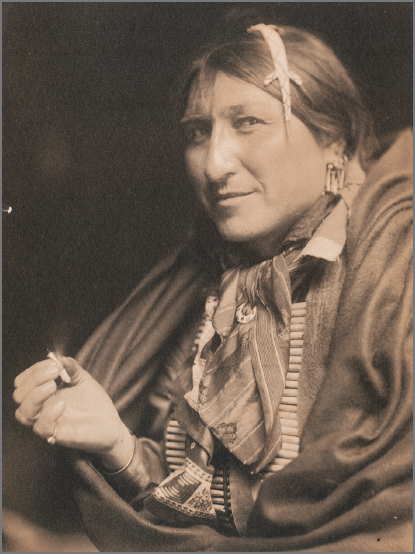Thinking Like a Historian: Representing Indians
The documents below, designed for white audiences, all depict American Indians in the West.
- Buffalo Bill Cody’s Wild West advertisement, 1899. Cody never called the Wild West a “show,” placing tremendous emphasis on its allegedly authentic reenactments of events.
 Superstock.
Superstock. - Lewis Henry Morgan, Ancient Society, 1877. Morgan, a leading American anthropologist, studied the Iroquois and other native peoples. In 1877 he published an influential theory of human development, ranking various peoples in their “progress” from the “lowest stage of savagery” through the pinnacle of “civilization” — northern Europeans.
Some tribes and families have been left in geographical isolation to work out the problems of progress. … [Others] have been adulterated through external influence. Thus, while Africa was and is an ethnical chaos of savagery and barbarism, Australia and Polynesia were in savagery, pure and simple. …The Indian family of America, unlike any other existing family, exemplified the condition of mankind in three successive ethnical periods. … The far northern Indians and some of the coast tribes of North and South America were in the Upper Status of savagery; the partially Village Indians east of the Mississippi were in the Lower Status of barbarism, and the Village Indians of North and South America were in the Middle Status. …
Commencing, then, with the Australians and Polynesians, following with the American Indian tribes, and concluding with the Roman and Grecian, who afford the highest exemplifications respectively of the six great stages of human progress, the sum of their united experiences may be supposed fairly to represent that of the human family. … We are dealing substantially, with the ancient history and condition of our own remote ancestors.
Status of Civilization (from Morgan, Ancient Society, 1877) I. Lower Status of Savagery From the Infancy of the Human Race to the commencement of the next Period. II. Middle Status of Savagery From the acquisition of a fish subsistence and a knowledge of the use of fire … III. Upper Status of Savagery From the Invention of the Bow and Arrow … IV. Lower Status of Barbarism From the Invention of the Art of Pottery … V. Middle Status of Barbarism From the Domestication of animals on the Eastern hemisphere, and in the Western from the cultivation of maize and plants by Irrigation … VI. Upper Status of Barbarism From the Invention of the process of Smelting Iron Ore, with the use of iron tools … VII. Civilization From the Invention of writing, to the present time. Table 16.2: TABLE 16.1 - Touring Indian Country, 1888 and 1894. Hoping to lure eastern tourists, the Northern Pacific Railroad published an annual journal, Wonderland, describing the natural splendors and economic progress of the West, as seen from its rail lines.
We are now in the far-famed Yellowstone Valley. … There are but few Indians now to be seen along the line of the railroad, and those are engaged in agricultural and industrial pursuits. The extinction of the buffalo has rendered the Indian much more amenable to the civilizing influences brought to bear upon him than he formerly was, and very fair crops of grain are being raised at some of the agencies. At the Devil’s Lake agency, for example, 60,000 bushels of wheat have been raised by the [Sioux and Chippewa] Indians in a single season. …
[The Crows’] great reservation is probably the garden spot of Montana, and the throwing open of a large portion of it to [white] settlement, which cannot long be delayed, will assuredly give an immense impetus to the agricultural interests of the Territory. …
The Flatheads have probably 10,000 or more horses and 5,000 or 6,000 cattle. … As ranchers and farmers the Flatheads are a success. It would be a matter of surprise to some people who think that the only good Indian is a dead Indian, to see the way some of the women handle sewing machines.
Sources: (2) Lewis H. Morgan, Ancient Society (New York: Henry Holt and Company, 1878), 12–13, 16–18; (3) John Hyde, Wonderland (St. Paul, 1888), 21, and 1894, 27.
- Gertrude Käsebier, photograph of Joe Black Fox, 1898. One of the first women to become a professional photographer, Käsebier here depicts Joe Black Fox relaxing with a cigarette. Black Fox, an Oglala Sioux, toured with Buffalo Bill’s Wild West in 1900.
 Photographic History Collection, National Museum of American History, Smithsonian Institution 69.236.22, 2004-57801
Photographic History Collection, National Museum of American History, Smithsonian Institution 69.236.22, 2004-57801
ANALYZING THE EVIDENCE
Question
i2C4f6FesXtO+K7lSCv7Tb1oSwTmnJ65SJXsfyP4fA90zp1+Iw5dn0kkLR1CMVdjw12+vKwCl4mDhJCX4vgrg5rw6Ee7NrD7GtM5AiyTqGwIkllVLOHrTx361AyPfgQhtARqhWcSuHiMMQ8e4PBC0dcfWYcarYbGrL45YRzgAkLhh7mdoyu1AC66Ynv109wv/b/DtagXTv5EcKLFKYIybn2HPICj53ZpapQQE7UxDTTM1TiNUKKIuaqvGUdNq5pY9NmwLAbfiII/vwQsHG7KND95Z00TEyOp5m441bxrbtGnOZRmb9rOicRTcO1Q3mYqioqXVJUf8rzgpBv56ygDBFwsQb7P7S6QCBxBSfu1YtJLJ8i7IwmO2dLCX3IXUpqBZ+Bgn/ZhMO49Zv7UxROxBhZRDwVU+MrnR/Vt282cMdhHXuOmBf7sjKbfP+2UUtyJf1X5Y1VuIIFzrxiFw22OSmnlLKkAyGL4nnuOvo3E5phVzLjhJJKrzTk4Nm9i+xVeU9kdXxSr15WoWbjXJi/VX865UUqZo15s3Wnthe/P/AmSFMn2WT6L1LHEfVILVrbsQuestion
ef340csIhA8M2pIzwdC+QhPF26ECeFUHSmC0vtqlUojDjWFQ6ldQmVHSNnEOWYWCSTLRUtjRI9CYr3GvMTU07rgzBymyY/v7rAYbrhYEXiKMKq+Tks96MEd8eNGgV2RokHbJ3iCm3gRk/8roFqheNRBNHTHB0ELP+BvgsnT412LU4ziIrOLnCbfJO3fHetGTFQeYW28eTFdQa27qccicBgm8xctECxdB1vX9UjaVbF8/nWquY+hMpxgpzgFxh4ZjsEa1piVpYGl7jrVAk/PMLbz6pcbLUjVyBnD+5RGLPcxVoKAB2noPAzxcRdYixXx0cUMrvkbhsa81qRhFk89Q61xovyPmL49nBvo3cQ==Question
nMnr7iPlxOmwLY80PSbF8feaOLERc8xur9jOHEf+XtNap+/57rpUsu+IUMc2zw2Uh6VC7y4S9wrLRkTkGt/YftdgAypbJ00irRpeZ+zEoRh9g2PzpJMIqT8KUs66W7qHZZTWLC3KZdVVzAgnhbA/kz1iJYOTh053+oPc/siWEKBG0foWzGvSbFMGSkeUSyC/0Tndi0hdxuWVLY8r7AGxcIlBePuOd4p1JoaWCxRTGGhi14pbFkpUl1PXEDvLlf4upnmwGMeZ4aA7Rp7BrCtiLFhbESy/iATDkasZBDgP5pFSvkBRiPUlo6gr/6aRJJqP+8+ZPw==Question
QL9xqw4CnqUlQ9fMjhQHS1eGy9WAKSlEdUks87Nfrf84ZBCerFw968TN183kYhyovO4/o1Xo3CyFy+QWhD/vXTZKUj0Z9ybzzh1nfNX70+Meg0AG+9fqy0MdvOwlenELl5cCoQTDNEh4LiSjbC9qETmswvTKp9LltrfX7fPgC7vsU60xSbeVF1/QuKIf03XsKp58YOTmPFIAQtVeYQ0V6Yc5ji3XJ8dBdNlL9F9cSxSXN9moNLvjsZr/d9yK2De1MFFs/A==
PUTTING IT ALL TOGETHER